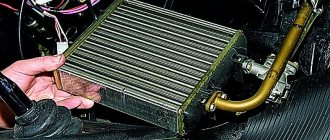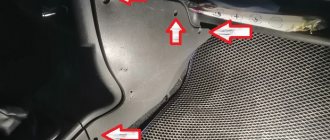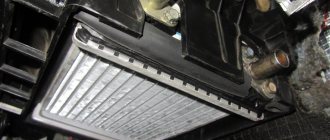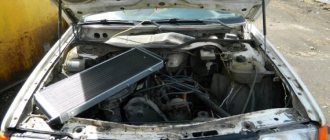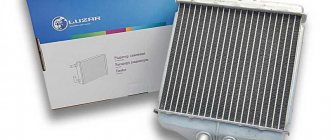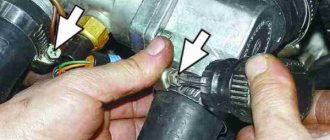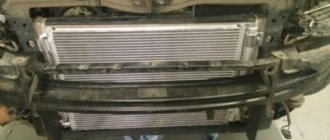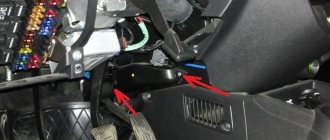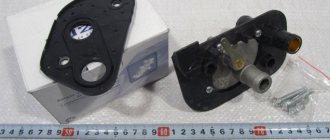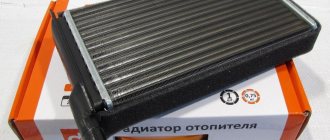The heating problem in the interiors of VAZ Samara cars is not particularly acute, since the heater is designed quite well. Sometimes the assembly and quality of components are upsetting, which nullify the entire structure. With the VAZ 2109 heater working completely properly, the microclimate in the cabin is within normal limits and there is no need to particularly complain. But as soon as one part fails, a series of dismantling works begins, which takes a lot of time and effort.
Containment:
- Heater device VAZ 2109
- About the reasons for the malfunction of the VAZ 2109 heater
- How to choose a heater radiator 2109
- Replacing the heater radiator 2109 without removing the panel
Disassembling the torpedo
First, we prepare a couple of containers; they will be needed for the machine parts. You can put plastic in one, and different screws in the other.
In order for us to get to the torpedo bolts, we need to remove the trim, which is located in its upper part;
Attention: You should prepare and place empty containers nearby; they will come in handy if coolant suddenly starts leaking. Take the volume within 6=7 liters
It's better to have a reserve.
- The most important thing is to purchase a radiator. Before paying, inspect and check it for defects and only after that make a purchase;
- Prepare the necessary tools. Put in a set of sockets and screwdrivers. After this, take a flashlight and you can begin further work;
- Replacing the VAZ 21099 radiator heater begins with closing the tap, and the heater should be set to cold. The engine must also be completely cooled;
- We unscrew the radiator mount, which consists of three bolts, raise the rod, which is located above the radiator and remove the pipes;
- When you remove the first pipe, be careful to place the container. A little liquid should come out of it, about 200 grams. Use clean containers; after repairs are completed, you can use this antifreeze back;
- We plug the first pipe with something and remove the second one. In principle, liquid should not come out of it, if only a small amount comes out;
- Replacing the radiator on the VAZ 21099 stove continues by removing the radiator. Which moves without problems, quite easily, but on the way of movement we will be prevented from doing this by the edge of the torpedo. You can raise it slightly by resting your back against the bottom edge of the glove compartment. After that, we place it on the lower mount, which is located on the passenger seat side. After this, the stove will come out freely;
- We attach foam rubber around the perimeter of the new radiator, which is sold complete with the part. In principle, any other sealant can be used;
- We insert the radiator into the heater housing. We put on the pipes and make the connection using clamps.
Attention: The clamps should be tightened after a couple of days. To avoid antifreeze leakage
Do not forget to lubricate the fittings on the radiator with silicone glue and only put this on the pipes;
Replacement of the heater radiator high panel VAZ 21099 is complete. Only after filling do we immediately check the operation of the stove. And you may be very surprised that it only heats up at high speeds. This may indicate the presence of an air lock. It can be removed in the following way:
- We park the car so that the front is higher than the rear. The higher the better.
- Remove the expansion tank cap;
- We set the engine speed to 4000, not lower. Let it run for 2-3 minutes. Then let it run for a couple of minutes at idle speed. After this, keep it at 4000 for a couple of minutes;
- After this, add antifreeze. Close the lid. Now everything will be fine.
Of course, such a breakdown can happen unexpectedly. But it is better to sometimes check the floor in the cabin under the rugs. This will allow you to detect the leak in time and eliminate the malfunction.
The stove doesn't heat well
If the stove does not heat well, and this can be due to several reasons.
This mainly happens due to the fact that the heater radiator itself is clogged, the method for flushing the radiator is as follows, the first method is to disconnect the heater hoses in the engine compartment and connect one of the hoses to the hose from the water supply, open the water as loudly as possible and let it flow through the heater radiator for a minute , then change the direction of water flow, connecting it to the other end of the radiator stove, and also let the water flow for about a minute.
The second method, swap the hoses connecting to the heater radiator so that the coolant begins to circulate in a different direction, also helps a lot, and the heater begins to heat well.
How does the heater work?
In order to understand how to correctly remove the device, for example, in the case when it is necessary to replace the body of the VAZ-21099 stove, it is worth familiarizing yourself with its design. In this car, the heater is located in the central part of the instrument panel between the engine shield and the dashboard on the air supply line, to which the heater is attached with four bolts. The design of the 99 VAZ stove is represented by two casings made of durable plastic (casing), between which there is a radiator. There is a fan on top of the heater housing that blows heated air to heat the interior. You can get to it through the engine compartment. In order to shut off the supply of hot coolant to the heater and turn it off during the warm season, a special tap is provided. The stove design also contains heat-conducting lines, pipes and rods.
Reasons why the heater radiator leaks
A coolant leak can be caused by the following factors:
- factory defects during the manufacture of the radiator;
- depressurization of the device due to corrosion processes;
- use of low-quality coolant, the composition of which promotes corrosion;
- mechanical damage to the heater.
Replacement process
It's puddles like these that make drivers scratch their heads and wonder what action to take. Not every VAZ-2108 car owner knows how to replace a cracked pipe. We hasten to assure you that the replacement process itself is unlikely to seem like one that requires the use of great physical force. However, along with this, you need to prepare yourself for the fact that you will have to lose some time, since getting to the problem pipe will not be so easy. You will need to unscrew and remove some other devices that prevent access to the pipes.
Algorithm of actions
First of all, remember that replacing elements involved in the cooling and heating system can only be done after the engine has completely cooled down. For this reason, give your car a chance to sit, rest after a long trip, and allow the engine to cool down. At this moment, you can afford not only to drink a cup of coffee, but even watch your favorite movie. You can personally spend the same time allocated for forced waiting by visiting specialized stores. Search for all the necessary auto parts, including purchasing an intake pipe.
The store specialist will definitely ask you what diameter the heater pipes of your VAZ-2108 have. If you do not have such information, then either measure in advance or find the answer to your question on the Internet. Once you have everything in place to carry out the replacement, and the engine has already cooled down, you can begin to take immediate action. By the way, when dismantling devices, we recommend that you visually inspect them to make sure that they are in good working order, and not bite your elbows when, in a few days, such a lengthy disassembly is required again due to the failure of another device
Pay special attention to hoses and rubber products
Prepare a large container into which to drain the coolant.
This is important, because when the components are disconnected, willy-nilly, the liquid will not just begin to flow out, but will flow in a continuous stream. Of course, if the fluid has already been used up, it’s not a shame to lose it, but if you just recently changed it, it’s better to keep the fluid so as not to expose yourself to additional unforeseen financial expenses.
In most cases, the hose is secured to the fittings using clamps. Take a screwdriver in your hands and loosen the clamp, then move it up a little to release the intake pipe. If you recently changed it, it can be removed without any problems, but if the installation process was carried out several months ago or even years, it will not be so easy to remove it. The pipes turn out to be “stuck” to the fittings. It is impossible to use physical force to disconnect a cracked pipe, since both it and the fittings are not very strong elements, so brute force can cause additional problems.
In cases where your careful efforts have not brought you closer to your cherished goal, pick up a hacksaw for metal and carefully cut off the pipe. Then cut the remaining part in several places and carefully remove it too.
Before putting the new pipe on the fitting, apply a special sealant to it. After this, tighten the clamps tightly to ensure a secure fit. All that remains is to refill the coolant. We recommend that you first remove the mixing chamber heating pipe that goes to the carburetor. This little trick will allow you to prevent the system from becoming airy.
So, replacing pipes is not a complicated procedure, especially if you first read the recommendations
It is only important to accompany each action with extreme care so as not to provoke damage to additional elements of the heating and cooling system
Heater diagram
The heater is mounted in the cabin under the dashboard using nuts on bolts that are welded to the air supply box. The air heated in the heater through channels (air ducts) enters the interior of the cabin. The air ducts are located at the bottom of the dashboard and have sealing gaskets.
If you plan to carry out repair and maintenance work, or replace failed components yourself, you definitely need to study the design of the stove and become familiar with the location of the components.
Based on the diagram below, we will introduce you to the design of the VAZ 2109 stove.
Scheme
| Item number | What is this |
| 1. | Bracket for fixing stove casings |
| 2. | Heater control damper |
| 3. | Left heater casing |
| 4. | Flap rod for heating the foot area |
| 5. | Radiator gasket |
| 6. | Radiator |
| 7. | Gasket sealing stove |
| 8. | Electric stove motor |
| 9. | Heater fan shrouds |
| 10. | Fan impeller |
| 11. | Heating damper |
| 12. | Air duct for heated windshield |
| 13. | Side nozzle duct |
| 14. | Side nozzle |
| 15. | Center nozzle flap |
| 16. | Pusher (blades); |
| 17. | Blade axis |
| 18. | The blade itself |
| 19. | Center nozzle closing lever |
| 20. | Heated windshield damper rod |
| 21. | Lever for changing air flow directions |
| 22. | Air heating control knob |
| 23. | Windshield air handle |
| 24. | Leg air handle |
| 25. | Bracket for control levers |
| 26. | Rod sheath fixation bracket |
| 27. | Stove valve control rod |
| 28. | Stove control damper rod |
| 29. | Heated footwell flap |
| 30. | Air control lever axis |
| 31. | Screw clamp |
| 32. | Stove valve |
| 33. | Heater valve body |
| 34. | Valve lever |
| 35. | Hoses connecting the faucet to the heater radiator |
| 36. | Internal ventilation duct |
| 37. | Heated windows for rear footwells |
| 38. | Stove tap |
| 39. | Window for heating the driver's foot area |
| 40. | B-pillar trim |
| 41. | Inner cavity of the central pillar |
| 42. | Exhaust ventilation duct |
| 43. | B-pillar trim |
| 44. | Hood deflector lining |
| 45. | Rubber valve |
| 46. | Deflector housing |
| 47. | Exhaust ventilation deflector |
| I | Heater |
| II | Stove operation diagrams |
| III | Stove tap |
| IV | Interior exhaust ventilation |
Having become acquainted with the components of the VAZ 2109 stove, let's find out in more detail how everything is arranged and functions here.
Device location
Principle of design and operation
- The stove includes a pair of plastic casings (left, right). They will be connected to each other with brackets around the perimeter. For sealing, a harness is placed in the grooves of the casings.
- An electric heater fan forces air inside the cabin. It is held in place by a pair of screws on top of the stove. The heater is designed in such a way that the fan can be easily removed through the engine compartment.
- An electric motor is attached to the fan casings. On its shaft there is a fan impeller with three speeds. This is possible due to the two coils of the resistor. To obtain the required wheel speed, there is an additional resistor. It is attached to the hole in the heater casing on the left.
- The radiator is located in the heater casings. Mounted to the right one using 3 fasteners and sealed with a polyurethane gasket. The radiator consists of two rows of tubes, cooling plates and plastic tanks. Also two.
- The heater valve consists of a housing, two pairs of pipes and is connected to the cooling system using rubber hoses.
- The liquid circulates through the radiator due to the operation of the cooling system pump.
- On the supply line in the heater faucet body, there is a faucet valve on the axis (it is plate-type), which has a hole for the passage of cooling liquid.
- The valve lever of the faucet is connected to the handle lever by a rod. The handle is responsible for controlling air heating. When the lever is turned, the valve hole opens the line and liquid begins to flow into the radiator.
- The stove is controlled using three handles. Their levers are located on the axes of a plastic bracket secured to the instrument panel with 4 screws.
- The heating control handle acts on the faucet lever by means of traction and on the damper drive lever. By moving the handle completely to the right, the valve and damper will fully open, and air will begin to flow with the help of a fan through the radiator, where the heated coolant is circulated.
- In the middle position of the handle, the valve and tap move to an intermediate position. Some of the air goes through the radiator, and the other part goes past it. This effectively ensures the degree of air heating required by the user at a given moment.
- If the handle is in the extreme left position, the valve and tap are completely closed. As a result, the air flowing into the cabin is not heated.
- The upper left handle is responsible for adjusting the air supply to the legs of passengers and the driver. It is connected to the damper lever by means of traction.
- By moving the handle to the left, the footwell heating flap opens and air flows through the casings into the corresponding windows.
- On the left and right, air is supplied to the feet of the front passenger and driver. Interior ventilation ducts allow air to be delivered to the rear passengers' feet.
- The handle that regulates the air supply to the windshield is connected to the drive lever for the heated windshield flap using a rod. It can close or open the path for air to pass through the ducts to the glass.
- To provide air supply to passengers and blow off the side windows of the car, the design of the stove provides 4 nozzles - a pair of central ones, left and right. The body of each of them is equipped with a damper with a seal. By closing or opening the damper, you regulate the intensity of air supply. Plus another lever allows you to control the direction of the air coming from the nozzle.
- The VAZ 2109 is equipped with an exhaust or exhaust ventilation system. With its help, air is sucked out of the cabin. In the case of the nine, the hood is located behind the body openings for the side windows. The exhaust also occurs through the vacuum that occurs at the deflectors while the car is moving.
If problems arise with the operation of the stove, you can visit a car service center. Either there is another option - remove the stove yourself and try to repair it, or entrust the work to specialists. In any case, by dismantling the device yourself, you will save a lot of money and gain important experience.
Express replacement of the VAZ 2109 heater radiator (without removing the dashboard and draining the coolant)
Hello. I want to tell you about the easiest way to replace the heater radiator on a VAZ 2108-99 with a HIGH torpedo. This method does not require removing it and draining the coolant. In total, the entire process will take approximately 1 hour. Otherwise, everything will depend on your speed of action. The only drawback to this method is that we will be cutting down the magazine shelf under the glove compartment.
You will need: 1) A hacksaw blade for metal 2) A Phillips screwdriver 3) A 7 or 8 wrench (depending on what clamps you have) 4) A new radiator 5) 3 champagne corks 6) A small container for coolant.
First you need to remove the lower console (the one that extends from the interior heating control levers to the gearbox housing). The only other thing I recommend doing for better comfort is moving both front seats as far back as possible. If you plan to replace the faucet in addition to the heater radiator, then it is best to pull up the carpet (for this you will also need to remove the plastic trim from the thresholds). With the carpet up, the tap will be completely accessible and you can lie straight in both front seats with your head pointing down towards the passenger's feet.
The lower hose is a supply hose, it is closed, the upper one drains the coolant, it cannot be closed
First, let's look at a method for replacing ONLY the heater radiator (without the tap). Of course, in this case we leave the old pipes.
And so, we take a hacksaw blade and cut down the bottom magazine shelf. Something like this:
you can screw it back with self-tapping screws
After sawing off, it will be clear that the radiator will come out without any problems, you just need to pull it out.
almost sawed off
Now we turn off the tap, prepare plugs and a container for coolant. The container is needed to drain the antifreeze that remains in the radiator itself.
Next, unscrew 3 bolts on each side of the radiator. Then we loosen the clamps (only those that fit the radiator), but do not tighten them yet. The most difficult part of this method is to drain the antifreeze from the radiator itself.
I recommend covering the entire floor with rags, because... It may happen that due to the slowness of your actions and/or carelessness, you will spill a fire. And this will happen no matter what. Therefore, place either rags or moisture-absorbing mats under the tap, under the radiator and at the feet of the front passenger.
Now we pull off the pipes from the radiator. First, the lower one (the one that is located at the bottom of the tap, we turned it off). Nothing will flow from the tap itself (since it is closed), we substitute the container and drain the antifreeze from the radiator. Keep your plug ready! About a liter or more will leak out. As soon as the container is full, plug the pipe with a stopper and prepare a new container. A champagne cork works best as a stopper. We repeat these manipulations until no coolant flows out of the pipe. We plug it with a cork.
The next step is to remove the outlet pipe from the radiator. Antifreeze can flow out of it, so it is not recommended to lower it down; keep it at the level where it is attached to the radiator, then nothing will flow out of it. There is no need to drain the antifreeze from here, just plug it with a plug.
After all this, we take out the old radiator and clean its place from leaves (I used a vacuum cleaner in the “blow-out” mode).
Now we do everything by analogy, in reverse order: 1) Insert a new radiator. 2) First we plug in the upper pipe (outlet). 3) Then the bottom one (nothing will flow from it, because the tap is turned off) 4) Tighten the clamps.
All. Just remember that an air lock may form. You can read about ways to eliminate it on the Internet.
If you are planning to replace the radiator and pipes, then we do everything the same way, only on the faucet itself you need to close the top plastic tube with the third plug. But keep in mind that antifreeze will pour out with force from there, you need to shut it up as quickly as possible.
If you don't want to saw off this shelf, the radiator can be stuck out between the glove compartment and this shelf. To do this, you need to unscrew all the bolts securing the torpedo on the right side and bend it. This method is well described here on the website, search for it.
How to remove the stove VAZ 21099 High Panel
Device on the device panel
Sometimes you open the car door, sit in the driver's seat, put the key in the ignition, start it, and fluid starts dripping from under the center console. And from time to time it doesn’t just drip, it pours. If you are an inexperienced car owner, immediately think about what happened. And if you have no experience, you know very well that the internal heating system does not work. Let's see how to remove parts of the VAZ 21099 stove for diagnostics without the help of professionals, repairs, and possibly modifications.
Let's first look at the design of this device. The VAZ 2108-21099 plate is located under the central panel, between the dashboard and the engine shield. Attach with 4 bolts to the air box. Consists of 2 plastic shells. left and right. There is a radiator plate inside the cases. It consists of 2 rows of tubes, heat transfer plates and 2 plastic reservoirs attached with 3 screws to the right shell. An electric fan is installed on the top of the heater; this is necessary to supply air to the cabin. It can be removed from the engine compartment. There is also a mixer for the stove. a miracle device that allows you to store hot antifreeze outside the heater, as well as draft and mixing pipes.
In the event of flooding in the cabin, you must first move the control knob to the last left position. This will save you from burns, engine overheating and the need to take another bucket of antifreeze. If the valve is closed, but coolant flows out from under the dashboard, this means that the pipes, hoses or valve have burst. In this case, you need to immediately brake, turn off the engine and either take the car to a service center, or remove the necessary tools from the trunk and begin repairs.
How to replace a VAZ 21099 radiator plate
To find out the scope of work, you need to find out the cause of the leak. First you need to look under the dashboard with a flashlight. The most common option is that if the inlet hose breaks, it will be immediately visible. Replacement takes minutes using a repair kit and a screwdriver. But the most common cause of leaks in the heating system is cracks in the radiator housing. Replacing the stove radiator. complicated thing.
In the engine cooling system, the interior heater is located immediately after the cylinder block jacket. All particles washed from the walls of the block enter the radiator tubes and become heavily clogged over time. The coolant enters the plate under enormous pressure, and the buildup causes this pressure to increase even more and break through the worn areas. Reality confirms the theory: where he is thin, where he breaks down.
Usually the motorist is accused of depressurizing the furnace, which was not checked, the device was not cleaned, and the hoses were not changed. This must be done without fail at least every 3 years.
First you need to figure out whether your car's center console is low or high. If the panel is low, then you are definitely out of luck. You have to sweat to take it off.
- First, turn the front wheels so they look straight.
- Then open the hood, remove the negative terminal from the battery, remove the suction cable from the choke lever, and disconnect the speedometer cable from the transmission.
- Remove the faucet handles.
- Remove by pulling the electric fan handle.
- Remove the 4 screws that secure the beard cover and put it on
- We disconnect all the plugs, marking or remembering which connectors will need to be connected later.
- Loosen the 4 screws that secure the control panel to the cooktop.
- Loosen the 2 screws that secure the visor to the instrument panel and remove it.
- Squeeze the clamps of the device panel and remove it from the dashboard.
- Disconnect the speedometer cable from the instrument panel and remove all plugs and fittings.
- Once you've pulled it out, remove the headlight levelers and instrument panel light switch.
- We unscrew the nuts for securing the headlight control and instrument panel lighting.
- Remove the steering wheel and change the jumpers.
- The ignition key is set to position “0” and disconnect the ignition switch connector.
- Unscrew the screws and remove the center panel.
Checking the system
Before you start work, you need to make sure that it is the heater radiator that is to blame for the malfunction.
- We bend the center console where the computer is located. We disconnect the shield from the overhead torpedo, here we will see the body of the heater itself;
- We take a flashlight and look, it should be visible if water is leaking. We immediately check the tap and pipes.
- Let's look at the leaks. The fact is, if the leak is not large, you might not notice it in the cabin.
Therefore, it is worth inspecting everything with sufficient quality.
You can watch the video on replacing the stove radiator on a VAZ 21099 on our website. But only after a thorough inspection can you begin to work.
Instructions for this topic are given below.
How does the heater work?
In the “ninety-nine”, the operating principle of the interior heating system is similar to similar models of the manufacturer and is as follows:
- With the onset of cold weather, the coolant supply is opened using the heater tap. After it warms up to operating temperature (90–100 degrees), the liquid begins to flow into the radiator.
- There is a special switch in the cabin that has three fan operating positions (speeds).
- In order to turn on the heater, it is enough to select one of the operating positions of its fan and, using special dampers, adjust the direction of supply of warm air (to the windshield, directly into the car interior, to the feet of the driver and front passenger, etc.).
If the heater motor is faulty, the car's heating system works extremely inefficiently, since it takes too much time to properly warm up the interior, since warm air enters it too slowly (or does not enter at all).
What is a thermostat and what is it for?
VAZ thermostat
Absolutely all brands of cars whose engines are cooled using liquids have a thermostat in their design. The “nine”, in which the thermostat is located between the radiator and the engine, is no exception. Replacing the radiator heater in a VAZ 2109 will be pointless if you don’t know how the thermostat works. As you know, the usual diameter of the thermostat hole is five centimeters. One of the main tasks of this car part is to block the flow of coolant into the heater radiator until the engine warms up. It is clear that coolant does not enter a cooled engine, but when the engine temperature reaches 95 degrees, the thermostat releases the liquid. Thanks to the thermostat, the engine warms up faster and it turns out that the part helps reduce engine wear and neutralize harmful exhaust gases.
Thermostat operating principle
The following experiment will help you see with your own eyes how a thermostat works:
- You need to put the part in a pan into which water is poured.
- Place the pan on the fire.
- As the water boils, you need to open the thermostat valve two centimeters.
The experiment will help you see the principle of operation of the device, which is hidden in a small thermostat cylinder. The cylinder is located in the place where the thermostat is turned towards the engine. This cylinder contains a ball made of artificial wax. It begins to melt at a temperature of 82 degrees. Due to its properties, the wax expands and squeezes the pin out of the cylinder, thereby opening the valve. Coolant flows through the radiator through an open thermostat. When the car engine is turned off, the wax in the thermostat cools down, thereby becoming hard again. In fact, the thermostat is a small thing, but very important. If it doesn't work well, it can stop any motorist on the road. The thermostat directly affects the operation of the heater radiator.
Replacement
Before you begin replacing the device, be sure to evaluate the condition of the new unit.
A mistake many people make is buying painted radiators. They may look more presentable, but in practice they have poor thermal conductivity. Moreover, the difference with an unpainted radiator is significant. Don't buy such devices.
Replacing the heater core can be done using two methods:
- With removal of the instrument panel;
- Without removing the dashboard.
Removing the panel makes the job easy and quite convenient. But you will have to spend at least 6-8 hours on this, depending on your level of preparation.
The second method does not require removing the panel, which makes the procedure more complicated. But it literally takes 2 hours to work.
Most car owners want to do everything quickly, but efficiently. The process of dismantling the panel takes a lot of time and requires careful fiddling with each fastener. Therefore, the best option for most is without removing the dashboard.
That’s why we’ll tell you about it in detail.
To work you will need:
- Ratchet;
- Set of heads;
- Set of screwdrivers (flat and Phillips);
- Container for draining antifreeze with a volume of 8-10 liters;
- Rubber gloves for protection;
- Spanners;
- Garage with a pit.
When everything is ready and you are ready to work, you can begin.
- Get into the hole under the car, having previously turned on the handbrake, placing supports under the wheels and removing the negative terminal from the battery. All in the name of safety.
- Drain the coolant from the radiator by unscrewing the drain plug.
- Next, after draining the antifreeze from the radiator, you will fill the container with approximately 2 liters. Let's move on to the drain plug on the engine. Antifreeze is drained in the same way as from a radiator. A hose with a diameter of 1 cm and a length of about 1 meter can help. All work on draining the coolant must be performed with the engine cooled down and wearing gloves.
- The plug for draining coolant from the engine is unscrewed with a 17 key.
- Loosen the pipe clamps and drain the remaining antifreeze from the stove system. Here you will have to lie down in the cabin with your head towards the engine, since the pipes can only be reached from the passenger side.
Dismantling process
- After draining the antifreeze, you can begin replacing the radiator itself.
- Remove the screws that hold the front panel in place.
- Unscrew the fasteners located on the rear wall of the glove compartment.
- You also need to remove the screw, which you will find near the side mirror on the passenger side.
- Once these fasteners are removed, the front panel will move freely up and down on the passenger side.
- To make your work easier, lift the panel as high as possible and insert something like a wooden block into the resulting gap. Usually you need a stopper about 7 centimeters thick.
- Lie on your back on the floor on the passenger side, unscrew the three fasteners that hold the heater in place. Get her out. The radiator has been removed.
- Apply a rubber seal to the new unit and insert the device in place of the old radiator. Don’t forget to clean the unit’s landing site first.
- Reassemble the unit.
- Fill the system with old or new coolant. This is an excellent reason to change the antifreeze if the old one has been in use for a long time.
Removed device
Antifreeze should be added sequentially. First add fluid to the reservoir up to the MAX mark. After this, you need to start the engine so that it runs for about 15 minutes. The antifreeze level will drop, and you can add the missing amount.
https://youtube.com/watch?v=-2eZ-KKjBuQ
The work is completed. The old radiator is recycled, the interior is tidied up and you can enjoy the result.
Loading …
Some useful tips
Finally, here are some tips to ensure that your car heater serves you for as long as possible.
- When deciding to replace the heater core, do not skimp. It is better to buy a high-quality original part once than to bother with its repair or replacement every year.
- Never use products of dubious origin and composition as coolants.
- Do not allow the radiator to remain idle for long periods of time without fluid. Even in summer, open the heater tap at least once a month to circulate coolant through it.
Sequence of actions when replacing a radiator
For most beginners, the question of how to remove a stove radiator is not such a difficult task. You should first prepare containers for small parts and liquid remaining in the hoses. The sequence of manipulations is as follows:
Dismantling
Unscrew the bolts located on the hose clamps. After which the radiator is disconnected from them
Important! When removing the hoses, you need to be prepared for the fact that residual coolant may spill out of them. In this case, keep a special container on hand. Remove the glove compartment. Unscrew the fastenings to the floor. Next, unscrew all the screws securing the radiator to the stove. The fastening of the cable that regulates the windshield blower damper is unscrewed. The radiator is disconnected from the stove
At this stage, problems with the torpedo are possible. To lift it up, you should rest your torso against the lower part of the glove compartment.
Installation
Next, a new radiator is installed. Actions are performed in reverse order. The car radiator is carefully installed, the torpedo is lowered down, the screws are screwed in, and they take their rightful seat.
Choice
When choosing a new radiator for the stove of your VAZ 2109, you should understand what exactly you want to achieve and what budget you have.
Today, consumers are offered two types of units to choose from.
| Radiator type | Peculiarities |
| Aluminum | A relatively inexpensive radiator option, which is characterized by high thermal conductivity. However, such a device cannot be repaired, which is its main drawback. But in practice, repairs are not carried out so often, so few people pay attention to this disadvantage |
| Copper | If necessary and a leak is detected, the copper radiator can be repaired - soldered. Thermal conductivity indicators are slightly higher when compared with aluminum analogues. But at the same time, the price is quite high - both for repairs and for the radiator itself |
Aluminum unit
Due to unprofitability and high cost, most VAZ 2109 owners choose aluminum radiators. But it all depends on your personal decisions and preferences. When actively using a car in harsh winter conditions, a copper radiator is fully justified.
Replacing the heater radiator on a VAZ 2109
Replacing the radiator of a VAZ 2109 stove is carried out with a complete disassembly of the torpedo and with a partial one. In this article we will look at how to carry out the replacement by partially disassembling the front panel. Also, there will be no need to drain the coolant, as is done in normal cases. A symptom of a faulty furnace radiator is a drip. Traces of coolant immediately appear on the carpet in front of the driver. Having purchased a new aluminum radiator, ceramic faucet, clamps, sealant, coolant and pipes, you can begin replacement.
An extra check wouldn't hurt
In order not to dismantle the stove radiator once again, it is recommended to check it. After all, it may be that the pipes or faucet are malfunctioning. In this case, the symptoms will be the same as with a faulty radiator. Therefore:
- bend the center console, disconnecting it from the top of the front panel;
- thus, the heater housing becomes visible, which must be carefully inspected with a flashlight.
Disassembling the torpedo
Disassembling the torpedo
Before replacing the radiator of the VAZ 2109 stove, the high dashboard panel must be disassembled. The top trim is removed to make it easy to get to the torpedo mounts. On the VAZ 2109 they are located in the upper part.
Disassembled dashboard
We begin the analysis, armed with a figured screwdriver, a set of heads and a screwdriver with a straight slot:
- remove the screws securing the dashboard from the top;
- remove the steering shaft casing;
- remove the nozzles intended for heating the side windows and ventilation on the instrument panel;
- remove the plug using a screwdriver;
- Unscrew the screw located under the plug.
Let's continue:
- disconnect electrical appliances;
- we find both loudspeakers hidden under the cladding;
- remove the lining.
Without removing the two plastic holders, it will not be possible to remove the lining. Replacing the radiator of a VAZ 2109 stove, a video of the process of which you can watch, is not an easy task. It will require patience and a little specific analysis knowledge. Continue:
- remove the loudspeakers secured with 4 screws;
- take out the wires;
- proceed to removing the shelf;
- unscrew the three screws located below;
- remove the glove compartment housing.
Replacing the heater radiator VAZ 2109 low panel
disconnect all elements of the dashboard.
Replacing a stove radiator on a VAZ 2109
Before you begin replacing the radiator, you need to wait until the car engine has completely cooled down. Also, the heater tap must be closed, or in other words, the stove must be in the cold position. This video will help you do everything correctly.
Let's get started:
- unscrew the radiator fastenings, fixed with three bolts;
- raise the rod above the radiator (it should not interfere with pulling it out).
- we find the heater radiator mounts and unscrew them;
- the heater radiator comes out without problems;
- After installation, everything is put back in place in the reverse order.
